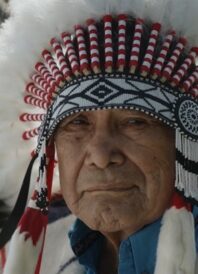
“Why are so many people attached to these fantasies when most of them have never even met a native person?” – Neil Diamond
In a compelling exploration of Indigenous influence, Cree Director Neil Diamond travels across Turtle Island—known to many as North America—and beyond to engage with members of various Indigenous communities and uncover the profound yet often overlooked contributions that Indigenous cultures have made to Western society. His journey delves into the realms of fashion, sports, governance, and agricultural practices, revealing a tapestry of cultural integration and appropriation.
Fashion: The Spirit of Identity
Fashion is one of the most visible arenas where Indigenous culture has left its mark. Items such as parkas, moccasins, and intricately beaded garments have become ubiquitous in modern fashion. Yet, these items hold deep cultural and spiritual significance for Indigenous peoples. Historically, Indigenous communities were often chastised and persecuted for wearing these sacred pieces. Diamond’s interviews reveal the heartache of the distance from these cultural elements stripped away while the government forced them into European assimilation. These traditional garments are not mere fashion statements; they are woven with the spirit of identity and survival.
Sports: The Sacred Movement of the Body
In sports, the influence of Indigenous practices is profound, though frequently unacknowledged. Running, regarded as a sacred form of movement, was vital for travel and for proving one’s worth within a tribe. Jim Thorpe, a residential school survivor and one of the greatest athletes of the 20th century, exemplifies this influence. As a member of the first Indigenous football team, Thorpe brought intelligence and strategy to the game. His school, Carlisle, is credited with popularizing the forward pass, a fundamental element of modern football. Despite this, Thorpe’s and his team’s success was appropriated and whitewashed, with their innovations being masked by racist team names, apparel, and chants. As Stephanie Fryberg (Tulalip Professor of Psychology at the University of Michigan) poignantly states, “You don’t have to feel bad about the past if we don’t exist anymore.”
Politics: The Wisdom of the Mind
Indigenous influence extends deeply into the political sphere. The Iroquois (Haudenosaunee) Confederacy, with its Great Law of Peace, served as a foundational model for modern democratic practices. This first form of a united nations demonstrated that peace could be achieved between warring groups. Women, symbolizing life through both agriculture and birth, held significant power. The Clan Mother was a pivotal political and economic figure, embodying the power of life.
European colonizers, accustomed to hierarchical and violent power structures, were often astonished by the respect and individualism inherent in Indigenous political practices. These practices influenced the founding fathers of the United States, aiding in the unification of the 13 colonies and the creation of its governmental branches. Despite this profound impact, ideas of equality are still not fully respected or represented throughout Turtle Island. For Indigenous people, a genocide of culture was inflicted by those who simultaneously looked to the Iroquois for guidance in creating a united nation.
Earth: The Heart of Connection
Reconnecting with the natural world is another area where Indigenous perspectives have had a significant impact. Indigenous values have served as the foundation for initiatives like summer camps that aim to reconnect children with the land. However, this often leads to cultural appropriation and a lack of respect for Indigenous cultural values and relationships with the land. What is often overlooked is the environmental impact and the loss of the natural world due to industrialization. Indigenous perspectives emphasize the interconnectedness of the food chain and the importance of all parts of the natural world. This is why the environment is an integral part of Indigenous culture. As Korina Emmerich (Puyallup Fashion Designer) highlights, “Indigenous people are responsible for protecting 80% of the land’s biodiversity.”
Neil Diamond’s journey reveals a crucial narrative: the rich and multifaceted contributions of Indigenous cultures to Western society remain underappreciated and often obscured. By exploring fashion, sports, politics, and environmental stewardship, Diamond uncovers a tapestry of influence. This tapestry challenges us to acknowledge and honor the Indigenous roots interwoven with the fabric of our contemporary world. “Our history and cultures are so rich that when people take the time to really get to know and understand us, they will see that the real thing is so much better than the fantasy,” says Diamond. His work invites us to deepen our understanding and respect for the enduring impact of Indigenous cultures.
- Rated: NR
- Genre: Documentary
- Release Date: 6/14/2024
- Directed by: Catherine Bainbridge, Neil Diamond
- Studio: Rezolution Pictures

